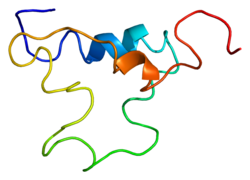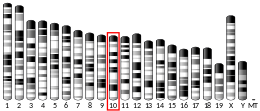
Back عامل النمو شبيه الإنسولين-1 Arabic عامل النمو شبيه الانسولين 1 ARZ IGF1 Welsh IGF-1 Danish Insulin-like growth factor 1 English Factor de crecimiento insulínico tipo 1 Spanish فاکتور رشد شبهانسولین ۱ Persian IGF-1 French Somatomedina C Galician IGF-1 HE
Insulinoliki faktor rasta 1 (IGF-1) – poznat i kao somatomedin C – je a hormon koji je sličan molekulskoj strukturi insulina. Ima značajnu ulogu u rastu tokom djetinjstva, a kod odraslih ima anaboličke efekte.
IGF-1 je protein kojeg kod čovjeka kodira gen IGF1.[5][6] IGF-1 sadrži 70 aminokiselina, u jednostrukom lancu sa tri unutarmolekulska disulfidna mosta. Molekulska težina mu je 7.649 daltona.[7]
IGF-1 se prvenstveno proizvodi u jetri. Proizvodnju stimulira hormon rasta (GH). Većina IGF-1 vezana je za jedan od 6 vežućih proteina (IGF-BP). IGFBP-1 regulira insulin. IGF-1 se proizvodi tokom čitavog života; najveće stope proizvodnje IGF-1 javljaju se tokom mladalačkog rasta. Najniži nivo se javlja kod novorođenčadi i u starosti.
Sintetski analog IGF-1, mekasermin, koristi se u djece za liječenje zatajenja rasta.[8]
- ^ a b c GRCh38: Ensembl release 89: ENSG00000017427 - Ensembl, maj 2017
- ^ a b c GRCm38: Ensembl release 89: ENSMUSG00000020053 - Ensembl, maj 2017
- ^ "Human PubMed Reference:". National Center for Biotechnology Information, U.S. National Library of Medicine.
- ^ "Mouse PubMed Reference:". National Center for Biotechnology Information, U.S. National Library of Medicine.
- ^ Höppener JW, de Pagter-Holthuizen P, Geurts van Kessel AH, Jansen M, Kittur SD, Antonarakis SE, Lips CJ, Sussenbach JS (1985). "The human gene encoding insulin-like growth factor I is located on chromosome 12". Hum. Genet. 69 (2): 157–60. doi:10.1007/BF00293288. PMID 2982726.
- ^ Jansen M, van Schaik FM, Ricker AT, Bullock B, Woods DE, Gabbay KH, Nussbaum AL, Sussenbach JS, Van den Brande JL (1983). "Sequence of cDNA encoding human insulin-like growth factor I precursor". Nature. 306 (5943): 609–11. doi:10.1038/306609a0. PMID 6358902.
- ^ Rinderknecht E, Humbel RE (1978). "The amino acid sequence of human insulin-like growth factor I and its structural homology with proinsulin". J Biol Chem. 253 (8): 2769–2776. PMID 632300.
- ^ Keating GM (2008). "Mecasermin". BioDrugs. 22 (3): 177–88. doi:10.2165/00063030-200822030-00004. PMID 18481900.







